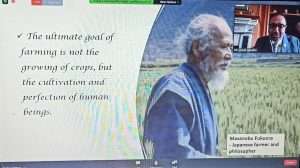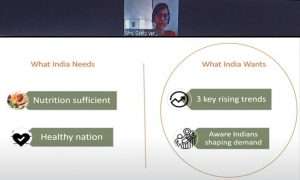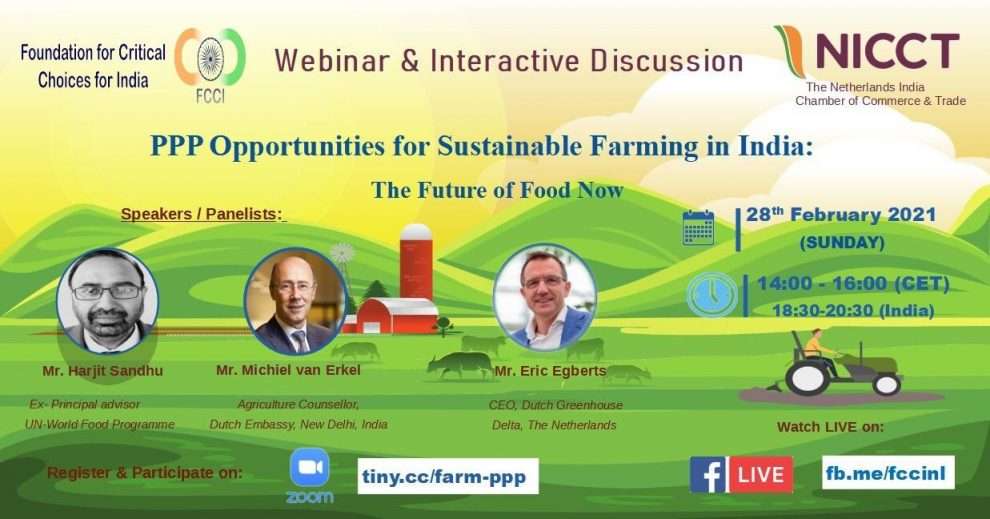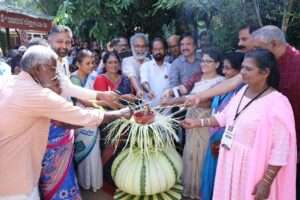This Meeting Note discusses the importance of public private partnerships (PPP) and the prospects it holds for sustainable farming in India. This is based on the insights gained from a webinar attended by Bhuvana.
CONTEXT
The Foundation for Critical Choices for India (FCCI) is one of the oldest think tanks of overseas Indians in the world. On the occasion of its 40th anniversary, a webinar was organized on ‘PPP opportunities for sustainable farming in India: The future of food now’.
At the outset, Dr Pramod Agrawal, Vice President of FCCI, stressed that FCCI mainly acts as a focal point for initiating and implementing studies and programmes on issues of strategic importance to India in social, political, and economic fields by mobilizing the resources of Non-Resident Indians (NRIs)/Persons of Indian Origin (PIOs). FCCI had organised a seminar on sustainable farming with the title ‘Sustainable Farming in India’ in 2013, where they concluded that collaboration and cooperation was needed to make sustainable farming a success. So, this webinar can inform us on how partnerships can promote sustainable farming based on experience from efforts made in India and The Netherlands.
The sessions included talks from four eminent speakers from India and The Netherlands, viz., Mr Harjit Sandhu (Ex-Principal Advisor, UN World Food Programme, Italy); Mr M. Michiel van Erkel (Agriculture Counsellor, Dutch Embassy, New Delhi, India); Mrs Geetu Verma (Global VP, Marketing, Food & Refreshments, Unilever, The Netherlands); and Mr Eric Egberts (CEO, Dutch Greenhouse Delta, The Netherlands). The webinar focused on sustainable farming and PPP opportunities in India, PPP in bilateral relationships, scope for PPP in rising trends for future food, and perspectives of the private sector on PPP.
SUSTAINABLE FARMING AND PPP OPPORTUNITIES IN INDIA
Quoting Dr MS Swaminathan, ‘If agriculture fails, everything else will fail’ and recollecting the success of the Green Revolution, Mr Sandhu presented his views about the importance of sustainable farming, challenges of Indian agriculture and scope for PPP in the present situation. He advised that before thinking of sustainable farming, one needs to analyse how the positive impact of the green revolution was severely tainted by its negative effects. For example, intensification of agriculture over the years has led to the overall degradation of the fragile ecosystem. The high cost of production and diminishing returns from agricultural practices affected the socio-economic condition of farmers. Loss of soil fertility, soil erosion, soil toxicity, diminishing water resources, pollution of underground water, salinity of underground water, increased incidence of human diseases, global warming, indiscriminate and disproportionate use of chemicals has polluted soil, air, water, feed and fodder for animals. So, to benefit from sustainable farming, most efforts must be directed towards ensuring four resources, viz., Sunlight, Air, Water and Soil, available for future generations, to grow crops and for healthy living of humans.
 Figure 1. Presentation of Mr Harjit Sandhu (Ex-Principal Advisor, UN World Food Programme, Italy)
Figure 1. Presentation of Mr Harjit Sandhu (Ex-Principal Advisor, UN World Food Programme, Italy)
Based on the negative impacts of the green revolution and challenges faced by Indian agriculture, Mr Sandhu discussed the opportunities for PPP in India. Presently, PPP has relatively better implementation in the development of transportation and infrastructure sectors rather than in agriculture. He believes that PPP can be a major game changer for the agriculture sector too, and can transform it at multiple levels. For example, with the government providing and co-financing the back end of the value chain and the private sector and farmer contribution doing the rest, the agriculture sector can still remain a primary engine of rural growth and poverty reduction in India.
To understand the PPP model, one needs to know the five basic components viz., Goal Commonality (shared vision), Strength Complementarity (I need you), Costs and Funding (no free lunch), Credits, Risks and Responsibility Sharing (we are partners), and Conflict Resolution (we decide). Commonly, the PPP efforts experience problems with trust, credibility, work culture, transparency, funds availability, business rules and legal framework. Addressing these problems will open up several windows of development opportunities. Having a ‘High-level national policy statement’ is suggested as a first requirement for effective implementation of PPP in the agriculture sector in India. This initiative will promote PPP in: agricultural research; devolution of powers; flexibility with accountability in public sector institutions; more studies and analysis of problems, prospects, mechanisms, etc.; and sponsoring fellowships to PG students of public research institutions by private sectors.
PPP can help to address the food security needs of a growing Indian population; the production, storage and distribution aspects also need to be optimized if we are to have sustainable agriculture. It can also effectively contribute to seed production, seed enhancements, farm implements and machinery, disease diagnostics and vaccines, bee keeping, value addition and post-harvest processing in cereals, pulses and oilseeds, fruits and vegetables, milk, meat and fish, product testing and evaluation. While the public-funded organizations have significant research results and the ability to absorb the uncertainties of payoffs, the private sector seems to have an edge in factoring clients into design of technologies and diffusion processes.
Realising the importance of PPP, the following opportunities were listed by the speaker:
Investing in smarter value chains
The food processing industries are emerging sectors in agriculture, where both government and the private sector have a role to play. The focus of food processing industries will be mostly to increase the shelf life of food preserving, food nutrients, and providing fortified products. It is time to expand their mandate with the PPP model, where the government supports investment and the private sector has a role to play by providing farm extension services, enhancing price realization, cutting out intermediaries, and improving the supply chain through forward and backward linkages. The mutual support of government and the private sector can help to create an enabling environment for private investment through tax rationalization, duty exemptions, increase in public spending, private sector lending and foreign direct investments (FDIs). This will catalyse private sector investments in the supply chain infrastructure and services, leading to a reduction in waste and greater value addition.
Improving access to credit, technology and markets
The advancement of technologies can help farmers to get information on the agriculture and allied sectors handily. The PPP projects targeted to helping farmers connect with their market places and financial institutions for micro funding can usher in massive alterations in the rural economy.
Building farmers’ resilience to environment shocks
PPP would be one of the solutions to immunize the agricultural sectors against the vagaries of nature such as floods, droughts and other such situations. The commonly observed phenomenon of farmer suicides in India can be reduced through the PPP model that deals with weather shocks, thus enabling farmers to de-risk themselves through insurance, etc.
PPP IN BILATERAL RELATIONSHIPS
The Counsellor of the Dutch Embassy, New Delhi, Michiel van Erkel presented his ideas on public private partnerships, both in general, and specifically on the bilateral relationship between India and The Netherlands. The Netherlands and India share a healthy relationship in several sectors. In agriculture, the collaboration is in the form of a bilateral agreement that was meant to mainly assist by sharing knowledge and technologies. The Indian Ministry of Agriculture and Farmers Welfare is the nodal agency for the implementation of this agreement. The knowledge and technologies are mainly shared with states and the centres of excellence. The centres of excellence are trained to provide the right technologies to meet the national goals of doubling farmers’ income, promote exports, sustainable production, and marketing.
Mr van Erkel explains that extension services to farmers for right information and knowledge is important and is best possible through PPP. But it is difficult to commercialize a service where the farmers’ willingness to pay for it is doubtful. However, this is not necessarily true in all cases. This is the point where the government’s intervention is important. For example, The Netherlands had challenging times after the World War. At that time there were efforts to make the farmers realise the importance of advisory services in agriculture. The government took the lead and invested more on extension services by convincing farmers of the necessity and usefulness of service. Slowly, those efforts have turned into commercial ventures, where farmers are now willing to pay for advisory services.
The discussion threw light on the importance of public sector in initiating, creating, stimulating and regulating such partnerships. For example, by creating a guarantee scheme, the procedure of lending to farmers by commercial banks can be eased, which could incentivize them to modernize their business. This indirectly increases the demand for advisory services too. Similarly, the time is now to promote a more sustainable, climate resilient and adaptive agriculture. From the experience of The Netherlands, it can be understood how important it is to promote innovations in agriculture with focus on sustainable and circular agriculture. It is necessary for the public sector to work with the private sector, both in the area of agricultural education as well as research.
Mr van Erkel’s experience with partnership projects in India and The Netherlands shows that to have sustained public private partnership opportunities, one needs to have good dialogue. This can help people to learn from each other in order to agree on the right interventions, cooperation and opportunities. Taking the example of The Netherlands, where the dialogue between ‘government’, ‘private sector’ and ‘knowledge institutes’ is called the ‘Golden Triangle’, he showed how it plays an important role in establishing partnerships. This can be further enriched by including other actors such as NGOs, thereby converting the Golden Triangle to ‘Dutch Diamonds’, and the success of Dutch agriculture can be attributed to this. Again, the important point to note from all this is that dialogue between partners is important and it is usually initiated by the public sector.
At present, the partnerships in Science, Technology and Innovations are translated into trade missions organized by governments. As an example, the first agricultural innovation mission in India organised by the Dutch embassy facilitated the participation and collaboration of more than 20 Dutch companies and knowledge organizations. When partnerships between countries are assessed, India is considered as an esteemed partner by The Netherlands – to work on the Sustainable Development Goals. It has potential to become the food factory of the world. There is much scope to improve efficiency and help farmers to earn a better income for their produce. The Netherlands always wants to be a partner to India so as to unlock the hidden potential in sectors such as horticulture, food processing, and animal husbandry. Europe, together with partners in India, have launched the first small decentralized fermentation production unit for the production of protein rich tempeh (a fermented food made from soybeans). The beneficiaries will receive a fair income and training, improving their production in a sustainable way. The first unit was partially financed by the Good Growth Fund from the Dutch government. As a government, they believe in the potential of the project that will have initiatives which support farmers and thus achieve the sustainable development goals.
RISING FOOD TRENDS IN INDIA AND SCOPE FOR PPP
Mrs Geethu Verma made a presentation on the landscape of Indian food system with the theme ‘Future of Food’. She initiated her discussion with the need to look at the Indian situation through the lens of ‘nutritional status of people’. Her discussion revolved around two questions: What does India need? and, what does India want?
What India Needs
India, during the immediate post-Independence period faced a situation where ensuring food security was the main concern. But today, even though food security is still important, there is an emerging need for ensuring quality food production along with quantity. When we think of food consumption, compare the food plates of India and western countries. Rice occupies the centre of the Indian plate, whereas protein is at the centre of the western plate. India lacks nutritional diversity in diets and there is need to create awareness about foods rich in protein, minerals, dietary fibres and others if the country is to move towards nutritional security. Recommending a balanced diet and making nutrient-rich foods affordable has the potential to drive the country into a healthy nation. Apart from government initiatives of healthy supplementation programmes, there is much scope for private sectors to explore these opportunities that can facilitate affordable protein in the requisite quantity, together with affordable food, which is high in dietary fibre and micronutrients, including fruits and vegetables.
 Figure 2. Presentation from Mrs. Geethu Verma
Figure 2. Presentation from Mrs. Geethu Verma
What India Wants
This section dealt with the three key rising trends and awareness among Indians who shape food demands. Three key rising trends in the Indian context where PPP can play an important role are as follows:
1) Nourishing both mind and body: The upper middle class, who have moved far from starvation diets, and moved on to the concept of ‘eating for nourishing the mind and body’, are mainly shaping this trend. This trend has increased the demand for meat and frozen meat products, dry fruits, protein supplements, fruit juices, beverages.
2) Food as medicine: The present COVID-19 situation has resulted in a renewed focus on the ancient knowledge and belief systems associated with Ayurveda for better health and immune system. Herbs, spices, and millets are gaining importance due to increased health consciousness among individuals.
3) Going organic: This is another important aspect of food production, projected to gain importance in the next five years due to increased health awareness and government support programmes. There are fragmented markets for organic produce. The private sector can work in this area to create brands and establish a market.
These three trends translate into a growing demand for dietary diversity, and healthy mindful eating. For increasing dietary diversity people have to move from a handful of crops and plants to a wider array of foods which are richer in nutrients, less water consuming, more drought resistant. Cereals, such as millets, also have the potential to regenerate soils and is good for the planet. This indicates that there are ample opportunities for both the public and private sectors to collaborate and work together to close up the evident gaps, and thus make balanced nutritious food available and affordable to the people so as to infuse nutritional diversity onto Indian plates.
PRIVATE SECTOR IN PPP
Mr Eric Egberts, CEO of Greenhouse Delta, spoke about the functioning of Greenhouse Delta and its collaboration in India on sustainable farming. Greenhouse Delta is an international foundation in The Netherlands, which represents the strength of the Dutch horticulture sector. Together with several national and international partners, they are positioned around the world to promote the Dutch horticulture sector worldwide bringing technology and knowledge together to feed the world. So Greenhouse Delta represents the entire horticulture chain, from seed cultivation, greenhouse construction technology, and logistics. They provide knowledge and sustainable solutions for growing a healthy crop.
The trend is to produce safe, healthy, fresh food and the only way to ensure this is to produce these locally. When it is not produced locally, it’s less sustainable, because of losses in long supply chains and energy consumption along the chain. So, developing local supply chains of agricultural commodities is a good avenue for partnership. However, the chain cannot be complete without the involvement of all the actors – necessitating partnership. The government plays a key role as it has to sanction, support and invest in research and development, knowledge centres. An alliance of public and private companies gives power to all stakeholders in the supply chain.
Greenhouse Delta believes that cooperation, applied research, management and education served as the critical success factors. The collaboration with government, private companies and R&D centres such as marketing universities, and sometimes NGOs, always helps projects to reach goals effectively. It always positioned itself at the centre of the partnership so as to build bridges between government, private companies and NGOs to stimulate the use of high-tech greenhouses. Collaborating with private sectors, like Greenhouse Delta that are scientifically and technically sound, always helps to get more from less. Mr Egberts supports the statement with an example of growing tomatoes in an open field and in high tech system to feed the world. Tomato grown under natural open field conditions produce roughly 150,000 kilos of tomatoes, and uses 28,000 cubic metres of water. But when you use a plastic greenhouse the yield is almost double and the use of water half. When you bring it to a proper greenhouse, the yield gets tripled, i.e., 500,000 kg and the use of water is further reduced enormously. These are the ways one can grow crops sustainably, in less space and with less resources. So, partnership of governments in India with such advanced technically sound companies can go a long way in promoting the horticulture/agriculture sector; and can be both economically viable and sustainable.
Though the benefits of partnership are evident, the larger and pressing question is how to ensure the partnership? Since India is dominated by small farmers, they need to be facilitated in setting up greenhouses and taught about vegetable cultivation. The only solution is to partner with local farmer groups/ NGOs or with the public sector and empower the farmers through Teaching and Education. So, we choose to go with the bottom up and top-down approach to help small farmers with new technology in collaboration with local IT sector, government and retailers.
Mr Egberts highlighted the opportunities in PPP for development as it will be like having all the needed ingredients on one plate, which only calls for leadership by one of the partners. This can ensure remunerative prices to farmers as well as access to healthy food for the consumer. To quote President Theodore Roosevelt: “Do something now. If not you, who? If not here, where? If not now, when?” When it comes to PPP in agriculture sector it is all right now; taking the lead and starting the work matters more than the result.
LESSONS LEARNT
Firstly, for ensuring successful PPP in agriculture good planning is needed – exploring the likely problems, and charting out solutions, mapping the network of actors who can complement each other, are all very crucial. From the discussions and cases presented, it appears that the government usually plays a central role in facilitating funds, human capital, legal framework to engage in partnerships, and private actors are mainly the source for technology and innovations. NGOs also are gaining importance for reaching farmers at the grassroot level for any partnerships. So, defining the roles and responsibilities, maintaining transparency, establishing good dialogue are all crucial for the success of partnerships. It is critical to create a win-win situation for partner’s results in success and sustenance of partnership.
Secondly, before entering into any kind of partnership, one needs to have thorough knowledge about the local situation as well as the national priorities and developmental goals. From all the presentations, one point became very clear – most of the PPP efforts had an objective of food security in addition to nutritional security. So, when we speak about improving access to quality food, we have to comprehend the whole food system and also the natural resource base. PPP efforts need to holistically address the issues in the food system in order to be successful.
Thirdly, the partners in partnerships must take into account current trends and forecasted scenarios while identifying the thrust areas needing collaborative action. International collaborations of both public and private actors can help in sharing and scaling up of advances in science and technology.
Acknowledgement
I thank the organisers of the webinar – FCCI and NICCT – and the panel of experts who have shared their knowledge and experience on sustainable farming and PPP through the virtual platform. I thank CRISP, Hyderabad for the information about webinar. This Meeting Note is prepared based on the learning gained from the inputs of experts.

Bhuvana N, is working with Centre for Research on Innovation and Science Policy (CRISP), Hyderabad as Consultant. She can be reached at email: bhuvana.rao7@gmail.com.





Add Comment